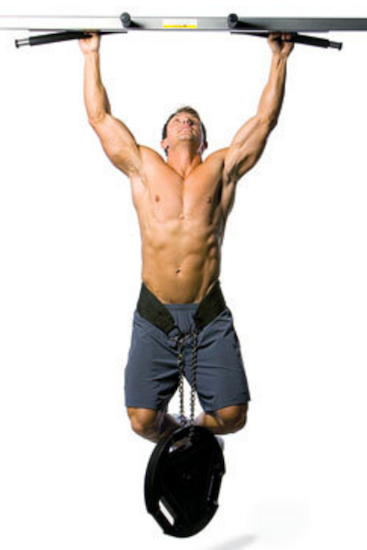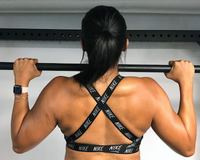
What is going on everyone! Today we’re going to go over pull ups — how to be able to do more reps and get results fast. Let’s not waste any more time and get right into it!
1. Master The Form
First off, proper pull up form is essential. To clarify, instead of focusing on kipping pull ups, where you use momentum to pull up, we are going to focus on strict wide pull-ups, which are one of the best exercises you can do to build large and strong lats.
For a proper pull up, your hands should be facing away from you. Your hand placement on the bar should be slightly wider than shoulder width apart. You also want your upper body in a relatively straight line.
This means your back should not be arched and your arms should be slightly in front of your body to allow the full range of motion.

If possible, you should try to have your legs straight and slightly in front of you. If you bend your knees forward, you create more of a stretch for the lats, but it makes the pull up much harder due to a lot more tension on the abs.
If you bend your knees backward, which is the most common position you see people do, then you will create some back extension and lose a lot of core engagement which encourages a swinging motion back and forth.
By having the legs straight, very slightly in front of you, forcing the toes down and squeezing the core, you will significantly increase your overall force production for executing the pull up as well as being able to stay much stricter without rocking.
To recap: Your palms are facing away from you and your hands are slightly wider than shoulder width apart. Your arms are slightly in front of the body and your back is straight. Lastly, your legs are straight and slightly in front of you with your toes pointed down.
2. Achieve A Full Range Of Motion
Along with correct pull up form, a full range of motion is essential. You should be coming to a dead hang for a split second at the bottom of the movement and bringing your upper chest as close to the bar as possible at the top of the movement.
How close you can get your upper chest to the bar will significantly depend on shoulder mobility. Pull up as far as you can and don’t cheat your reps!
3. Strengthen Your Lats And Biceps
The lats, which are the largest muscles of the back, and the biceps are the two main muscles activated in the pull up. There are multiple other muscles that play a role in the motion but these two have the greatest impact.
For lats, you want to focus on any rowing type of movement and for the biceps, emphasize any curling movements.

Now, when people think lats, they generally refer to them as the wings or width of your back.
They do stretch to the sides of the back as well as behind the arms, but they are also partly covered by the traps near the midline of the back. This section of the lats is significantly worked in the pull up.
Regarding the biceps, a lot of people don’t think biceps are important. But for the pull up, as you pull your elbows down and slightly back, the biceps are highly activated.
Since these muscle groups are vital to your pull up performance, in order to be able to do more reps, you have to strengthen them.

The most optimal rep range for strength workouts is 1-5 reps, so to optimally strengthen your lats and biceps, when doing your main exercises to target those muscle groups, utilize that rep range for optimal strength gains. The hypertrophy range of 6-12 will also help yield progress as well as promote muscle development.
4. Strengthen Your Rotator Cuffs
The rotator cuff consists of four main muscles: the supraspinatus, infraspinatus, teres minor, and subscapularis. In fact, the rotator cuffs actually play a significant role in the pull up.
Most people do rotator cuff exercises for rehab or injury prevention. But specifically the infraspinatus and the teres minor help to assist the lats for shoulder adduction.
In other words, these muscles help move the upper arm bone into the body while pulling upward toward the bar to complete the pull up. The infraspinatus muscle of the rotator cuff is actually considered the third most activated muscle group in the pull up.
Also, one of the responsibilities of the lats is internal rotation of the shoulder joint. Therefore, the sturdier we can make the muscle surrounding the shoulder joint, the more support the lats will have.

In order to see how to be able to do more pull ups, you need to be placing an individual training focus on the rotator cuff.
These are your isolated shoulder rotation exercises, both internally and externally. However, for these type of movements, you cannot lift heavy weights.
These aren’t strength based exercises. I recommend you go light using a weight where you can do a minimum of 20 reps.
Don’t neglect rotator cuff training — as you now know, it’s not just for prehab or rehab, but also will significantly help you increase the amount of pull ups you can do!
5. Incorporate Negatives Into Your Training
A great method to increase the amount of pull ups you can do is by incorporating negatives into your training. Negatives are focusing on the eccentric part of the pull up — the part where you lower yourself down.
By controlling this part of the movement in a slow fashion, you will enhance muscle growth by working your muscle fibers in a different way.
Focusing on the negative actually will help increase muscular endurance — the more muscular endurance you have, the more pull ups you will be able to do. Also, this will train your body to be stricter in avoiding that rocking movement.
Not only does rocking back and forth take tension away from your back, but it actually limits your range of motion.
6. Add Resistance
Another great way to increase the amount of pull ups you can do is by doing weighted pull ups. The most common way you see people do this is with a dip belt.
However, you can also put a dumbbell between your legs or use of a weighted vest. Now this is obviously a much more advanced method. I wouldn’t recommend doing this until you can do 10 strict pull ups in a row at least.

When you are capable of doing this, you will be able to build and strengthen the muscles involved in the pull up even more. By building these muscles more and by practicing pull ups and doing more reps more quickly, you will create more force. As you become more efficient with the pull up form, you will generate more power.
Doing weighted pull ups help you become more powerful, especially because afterwards, bodyweight pull ups will feel way easier!
7. Plan Your Progression
Lastly, progression is essential. Since your goal is to increase the amount of pull ups you can do, don’t do them daily. Instead, allow your muscles at least 24 hours to recover. Do your pull ups first before your strength workout. Every third pull up session, increase your total reps by 10.
For example, let's say you do pull ups every other day and after your first two sessions you had 40 total pull ups as your goal. The next two sessions your total rep goal should be 50.
Do as many reps as you can in a row, take a rest, and keep doing so until you hit your total rep goal. You want to train the endurance of your body doing the pull up motion.
But What If I Can't Do A Single Pull Up?
If you can’t yet do a pull up, you have to do assisted pull ups. If you’re lucky enough to go to a gym that has an assisted pull up machine, use it and work your way up.
If your gym doesn’t have one or you’re at home, you can have a buddy hold your legs and push up and help down for assistance. You could also use a resistance band!

We all start somewhere and it’s important not to get discouraged. You will keep getting better and better! Pull ups are in my opinion one of the hardest exercises.
Even if you can’t do one without assistance yet, the same progression method applies until you can. Keep working up. It is essential to improving.
Join the Invasion!
This Anabolic Aliens membership will grant you access to workout classes, rehab programs, diet plans, and more exclusive content to help you achieve sustainable success!










